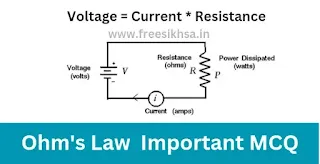What is Ohm's Law
Ohm's Law states that the current flowing through a conductor between two points is directly proportional to the voltage across the two points, provided the temperature and other physical conditions remain constant. This relationship can be expressed mathematically using the following formula:
V = I * R
Where,
V = voltage (measured in volts)
I = current (measured in amperes)
R = resistance (measured in ohms)
According to Ohm's Law, if you increase the voltage across a conductor, the current flowing through it will also increase, as long as the resistance remains constant. Conversely, if you increase the resistance, the current will decrease for a given voltage.
Latest Ohm's Law MCQ Objective Questions
1. What is Ohm's Law?
A) The amount of electricity flowing through a wire between two points is related to how much voltage there is across those two points.
B) The voltage across a conductor is directly proportional to the resistance of the conductor.
C) The power dissipated by a conductor is directly proportional to the current flowing through the conductor.
D) The resistance of a conductor is directly proportional to the temperature of the conductor
Answer: A) The amount of electricity flowing through a wire between two points is related to how much voltage there is across those two points.
2. Which of the following is the correct formula for Ohm's Law?
A) V = IR
B) I = VR
C) R = IV
D) V = RI
Answer: A) V = IR
3. If the resistance of a circuit remains constant, what will happen to the current if the voltage is doubled?
A) The current will double
B) The current will be halved
C) The current will remain the same
D) The current will increase by four times
Answer: A) The current will double
4. A resistor has a value of 100 ohms. What is the current flowing through the resistor if the voltage across it is 10 volts?
A) 0.1 amps
B) 1 amp
C) 10 amps
D) 100 amps
Answer: A) 0.1 amps
5. Among the following materials, which material has the highest resistance?
A) Copper
B) Aluminum
C) Silver
D) Tungsten
Answer: D) Tungsten
6. If the current through a 20 ohm resistor is 5 amps, What is the amount of electrical pressure or potential difference present across the resistor?
A) 0.25 volts
B) 5 volts
C) 20 volts
D) 100 volts
Answer: C) 20 volts
7. A circuit has a voltage of 12 volts and a resistance of 3 ohms. How much Current is passing through the resistor?
A) 4 amps
B) 9 amps
C) 36 amps
D) 144 amps
Answer: A) 4 amps
8. Which of the following is a unit of resistance?
A) Volt
B) Ampere
C) Watt
D) Ohm
Answer: D) Ohm
9. A 6-volt battery is connected to a 2-ohm resistor. How much Current is passing through the resistor?
A) 3 amps
B) 6 amps
C) 12 amps
D) 18 amps
Answer: B) 6 amps
10. Which of the given example of a non-ohmic device?
A) Resistor
B) Capacitor
C) Diode
D) Inductor
Answer: C) Diode
11. Which of the given statements is true about a series circuit?
A) The current Passing through each component is the same.
B) The voltage across each component is the same.
C) The sum of the individual resistances in a circuit is equal to the total resistance of the circuit
D) All of the above.
Answer: D) All of the above.
12. Which of the following statements is true about a parallel circuit?
A) The voltage flow across each component is the same.
B) The current Passing through each component is the same.
C) The sum of the individual resistances in a circuit is equal to the total resistance of the circuit
D) All of the above.
Answer: A) The voltage flow across each component is the same.
13. What is the resistance of a circuit if the voltage is 6 volts and the current is 2 amps?
A) 8 ohms
B) 3 ohms
C) 12 ohms
D) 0.33 ohms
Answer: B) 3 ohms
14. If the resistance of a circuit is halved and the voltage is kept constant, what will happen to the current?
A) The current will double.
B) The current will be halved.
C) The current will remain the same.
D) The current will quadruple.
Answer: A) The current will double.
15. Which of the following is a formula for calculating power?
A) P = IV
B) P = I^2R
C) P = V^2/R
D) All of the above.
Answer: D) All of the above.
16. A circuit has a voltage of 10 volts and a resistance of 2 ohms. What is resultant power dissipated by the circuit?
A) 5 watts
B) 10 watts
C) 20 watts
D) 50 watts
Answer: B) 10 watts
17. Which of the given factors can affect the resistance of a conductor?
A) Temperature
B) Material
C) Length
D) All of the above
Answer: D) All of the above
18. What is the resistance of a circuit if the voltage is 12 volts and the current is 4 amps?
A) 3 ohms
B) 4 ohms
C) 12 ohms
D) 48 ohms
Answer: A) 3 ohms
19. Which of the given unit of power?
A) Volt
B) Ampere
C) Watt
D) Ohm
Answer: C) Watt
20. Which of the following statements is true about a variable resistor?
A) Its resistance remains constant.
B) Its resistance can be changed by adjusting a knob or slider.
C) It is also called a fixed resistor.
D) It is not affected by changes in temperature.
Answer: B) Its resistance can be changed by adjusting a knob or slider.


